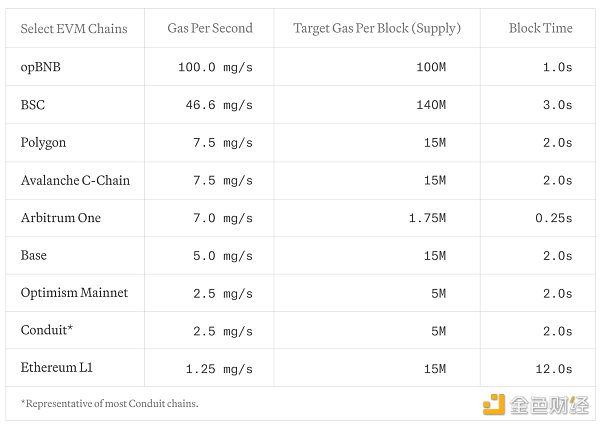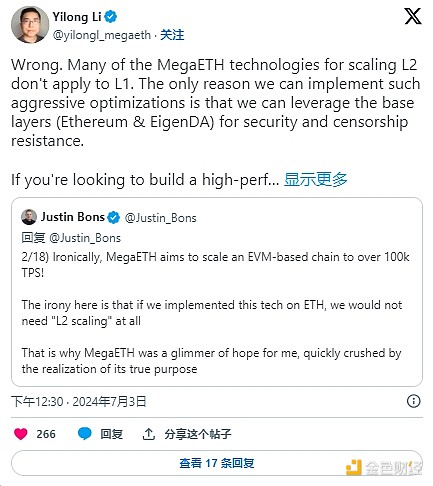Author: Jack Inabinet, Bankless; Translator: Tao Zhu, Golden Finance
MegaETH, the upcoming L2 project known as "Real-time Ethereum" with sub-millisecond latency and the ability to process over 100,000 transactions per second (TPS), just announced $20 million in seed funding at a valuation of over $100 million!
The star-studded round was led by Dragonfly Capital, with participation from big names such as Ethereum founder Vitalik Buterin, Consensys founder Joe Lubin, Lido/Flashbots strategy lead Hasu, prolific crypto trader Cobie, and EigenLayer founder Sreeram Kannan.
The big names involved have drawn some attention to the project in the market.
Today, we will discuss how MegaETH innovates on the contemporary Ethereum Virtual Machine (EVM) blockchain to provide industry-leading performance and decentralization guarantees.
What’s special about MegaETH
High-performance alternatives to L1 require their nodes to perform the same tasks without specialization, creating a fundamental trade-off between performance and decentralization. In contrast, MegaETH leverages Ethereum’s L2 technology to create differentiated roles for nodes with different hardware requirements.
MegaETH decouples transaction processing tasks from full nodes and creates three main roles for infrastructure operators: orderer, prover, and full node. While MegaETH’s actual block production is becoming increasingly centralized, the flexible hardware requirements for node specialization ensure trustless block validation and can provide industry-leading decentralization guarantees.
A single active MegaETH sorter will be responsible for sorting and executing user transactions, eliminating the consensus process during normal operation, and will communicate state differences (i.e. changes to the blockchain state) to full nodes via the peer-to-peer network, which then apply the state differences to update their local state. It is worth noting that MegaETH transactions are not re-executed by full nodes to verify block integrity; instead, they indirectly verify blocks using proofs provided by provers.

Even the highest-performing L2 in existence (BNB's opBNB) imposes significant limitations on its application. Despite opBNB's relatively high throughput target of 100M Gas per second, opBNB can only handle 650 Uniswap swaps per second compared to modern Web2 databases that can achieve an equivalent 1M TPS.
In addition, these networks tend to have "long" block times of more than 1 second, which is impractical for applications that require real-time performance (such as high-frequency trading).

While blockchains often turn to one-off solutions such as parallelization in pursuit of scale, enabling transactions involving different parts of the state to be processed simultaneously on multiple CPU cores, the benefits of this particular approach are limited by the fact that many transactions contain dependencies, resulting in only a modest improvement in blockchain speed from parallelization.
Solving any system's bottlenecks alone typically fails to produce significant improvements, as solving the initial limiting factor simply shifts the bottleneck to another component.
Rather than optimizing just a few components of its stack like its competitors, MegaETH aims to identify the myriad problems plaguing existing blockchains and build a new system to solve a range of problems discovered simultaneously.
Such ambitions require scaling node hardware to its limits while maintaining decentralization (achieved through specialization) and creating a system that is essentially designed to approach the theoretical performance ceiling of a decentralized blockchain.
To this end, the MegaETH sorter will store its entire state in memory and become the first blockchain to implement in-memory computing, a key feature for high-performance Web2 applications, which should enable MegaETH to access state 1,000 times faster than alternative solid-state drive storage methods used by competitors.
Compute-intensive applications will see a 100x performance boost on MegaETH thanks to a just-in-time (JIT) compiler, which converts smart contract code into MegaETH’s “native machine code,” a set of instructions that a server CPU can directly interpret and execute, helping to increase the speed and efficiency of smart contract execution.
Maintaining the Ethereum Merkle Patricia Trie (MPT), a core data structure that represents the current state of all assets and related information, is the primary limiting factor of all EVM implementations, but MegaETH is creating a new state trie from scratch that will maintain a fully EVM-compatible state trie while minimizing disk I/O operations and storing terabytes of state data.
Finally, MegaETH’s 100,000 transactions per second must propagate to its network of full nodes; an efficient peer-to-peer protocol will deliver state updates from the sequencer with low latency and high throughput, allowing full nodes with moderate connectivity to stay in sync at the maximum update rate.
Conclusion
MegaETH’s significant performance improvements over contemporary EVM implementations should greatly drive adoption of L2 performance and ultimately produce decentralized blockchains capable of handling the real world!
While some argue that MegaETH is best suited as a competitor to the Ethereum ecosystem that is not interested in the base layer, the optimizations achieved by MegaETH are entirely achieved through its ability to outsource security and censorship resistance to existing decentralized networks such as Ethereum and EigenLayer.

 JinseFinance
JinseFinance
 JinseFinance
JinseFinance JinseFinance
JinseFinance JinseFinance
JinseFinance JinseFinance
JinseFinance Bitcoinist
Bitcoinist Coindesk
Coindesk Bitcoinist
Bitcoinist Cointelegraph
Cointelegraph Cointelegraph
Cointelegraph Bitcoinist
Bitcoinist